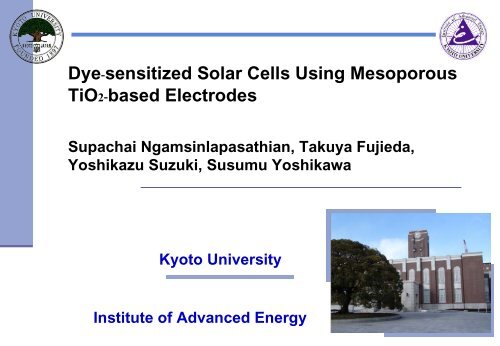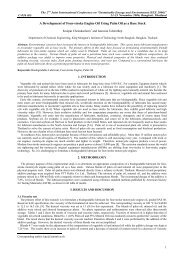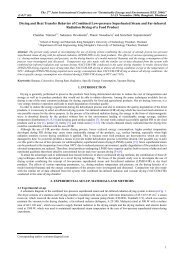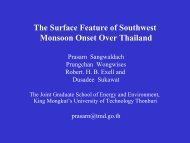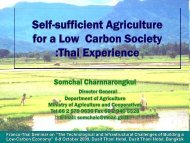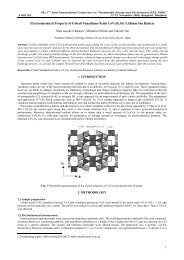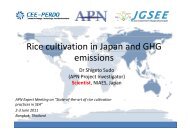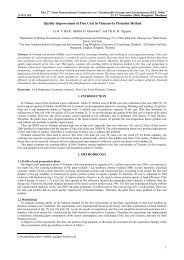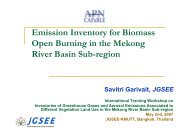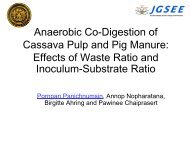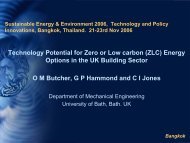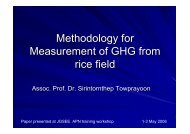Dye-sensitized Solar Cells Using Mesoporous TiO2-based Electrodes
Dye-sensitized Solar Cells Using Mesoporous TiO2-based Electrodes
Dye-sensitized Solar Cells Using Mesoporous TiO2-based Electrodes
You also want an ePaper? Increase the reach of your titles
YUMPU automatically turns print PDFs into web optimized ePapers that Google loves.
<strong>Dye</strong>-<strong>sensitized</strong> <strong>Solar</strong> <strong>Cells</strong> <strong>Using</strong> <strong>Mesoporous</strong><br />
<strong>TiO2</strong>-<strong>based</strong> <strong>Electrodes</strong><br />
Supachai Ngamsinlapasathian, Takuya Fujieda,<br />
Yoshikazu Suzuki, Susumu Yoshikawa<br />
Kyoto University<br />
Institute of Advanced Energy
Introduction<br />
Energy and Environmental Crisis<br />
Pollutant emission factors for<br />
electrical generation (g/kWh)<br />
1<br />
Energy Source CO 2<br />
Coal 322.8<br />
Oil 258.5<br />
Natural Gas 178<br />
Photovoltaic 5.3<br />
<strong>Solar</strong> cell is one of the most promising<br />
ways to solve these problems !!!<br />
The strong points of solar cells are:<br />
direct conversion of solar radiation into electricity,<br />
no mechanical moving parts, no noise,<br />
no high temperatures, no pollution,<br />
solar cell module have a very long lifetime,<br />
the energy source, the sun, is free and inexhaustible,<br />
solar cell is a very flexible energy source,<br />
its power ranging from microwatts to megawatts.
Introduction<br />
2<br />
Several works have been directed toward improving the efficiency of<br />
dye-<strong>sensitized</strong> solar cells.<br />
Developing new dyes Suppressing electron<br />
recombination<br />
Improving<br />
photoelectrode<br />
Energy level<br />
E/V vs NHE<br />
-0.5<br />
E c (-0.5 V)<br />
Electrons<br />
Injection<br />
<strong>Dye</strong><br />
Load<br />
LUMO<br />
(-0.7 V)<br />
Fermi level<br />
Counter electrode (Pt)<br />
0<br />
TiO 2 electrode<br />
ΔE 1 ΔE 2<br />
Excitation<br />
Max voltage<br />
0.5<br />
E g<br />
I - /I 3- redox mediator<br />
(0.4 V)<br />
1.0<br />
HOMO<br />
(1 V)<br />
Electrolyte<br />
TCO Glass<br />
TCO Glass
Introduction<br />
3<br />
Light harvesting efficiency is very important factor for solar cell performance.<br />
Synthesized by Hydrothermal process<br />
Absorbance<br />
A (small size)<br />
A<br />
N719<br />
Wavelength (nm)<br />
M (A+B)<br />
(small size + large size)<br />
M<br />
TiO 2 particles BET surface area (m 2 /g)<br />
IPCE (%)<br />
A (23 nm) 66.3<br />
B (100 nm) 15.4<br />
Type of plate<br />
Nanoparticles<br />
A (23 nm) B (100 nm)<br />
A 100 0<br />
M (A+B) 60 40<br />
23 nm<br />
100 nm<br />
A<br />
M<br />
Schematic film morphologies of TiO 2 photoelectrodes<br />
Arakawa et. al., Coordination Chemistry Reviews, 248 (2004) 1381-1389.<br />
Wavelength (nm)
Introduction<br />
4<br />
Current density (mAcm -2 )<br />
DSC made from multilayer TiO 2<br />
Some researchers added ZrO 2 or SiO 2 in TiO 2<br />
η 10.23%,<br />
Jsc 18.17 mAcm -2 ,<br />
Voc 764 mA, and<br />
FF 0.737<br />
Ref 1<br />
Current density (mAcm -2 )<br />
η 9.04%,<br />
Jsc 18.8 mAcm -2 ,<br />
Voc 740 mA, and<br />
FF 0.640<br />
Ref 2<br />
Photovoltage (V)<br />
Photovoltage (V)<br />
To balance the surface area and light<br />
scattering, multilayer was introduces<br />
as the electrode for DSC.<br />
for scattering the light.<br />
1) Arakawa et. al., Coordination Chemistry Reviews, 248 (2004) 1381-1389.<br />
2) Lee et. al., <strong>Solar</strong> Energy Materials & <strong>Solar</strong> <strong>Cells</strong>, 90 (2006) 2398-2404.
Aim of this work 5<br />
To propose the new approach to prepare mesoporous<br />
titania by surfactant-assisted templating method<br />
To optimize sintering condition for preparing the<br />
electrode of dye-<strong>sensitized</strong> solar cells<br />
To prepare electrode for obtaining high solar energy<br />
conversion efficiency by using double-layered structure
Experimental 6<br />
Preparation method of nanocrystalline mesoporous titania<br />
Step A<br />
Step B<br />
Tetra-isopropylorthotitanate(TIPT) + Acetylacetone(ACA)<br />
Ti(OCH(CH 3<br />
) 2<br />
) 4<br />
+ CH 3<br />
COCH 2<br />
COCH 3<br />
(TIPT)<br />
(ACA)<br />
0.1M LAHC aq. Solution (pH 4.5)<br />
H<br />
H 3<br />
C C CH 3<br />
C C<br />
O<br />
Ti O<br />
Surfactant : Laurylamine hydrochloride(LAHC)<br />
CH 3 CH 2 CH 2 CH 2 CH 2 CH 2 CH 2 CH 2 CH 2 CH 2 CH 2 CH 2 NH 3+ Cl -<br />
Pri<br />
[TIPT-ACA] / [LAHC] = 4<br />
After mixing After 1day After 3h After 5h After 5 days<br />
O<br />
O<br />
OPri<br />
Pri<br />
+<br />
HOCH(CH 3<br />
) 2<br />
Wash with IPA<br />
40℃<br />
80℃ 80℃ 80℃<br />
stirring<br />
reaction
TEM images<br />
7<br />
(101)<br />
(004)<br />
(200)<br />
(215)<br />
The size of MP-TiO 2<br />
was estimated to be 7 to<br />
15 nm.<br />
Electron diffraction of MP-TiO 2<br />
displays<br />
the Debye-Scherrer rings of anatase.
XRD & BET surface area<br />
8<br />
Intensity/ a.u.<br />
A<br />
R<br />
A A<br />
AA AA T45<br />
MPTiO 2<br />
R R R<br />
P25<br />
20 30 40 50 60 70 80<br />
2theta/ degree<br />
commercial<br />
synthesized<br />
commercial<br />
Adsorbed amount / ml(STP) g -1<br />
200<br />
150<br />
100<br />
50<br />
0<br />
MPTiO 2<br />
Type IV<br />
0 0.5 1<br />
Relative pressure P/P 0<br />
Synthesized TiO 2 had a prevalent<br />
mesoporous structure<br />
MPTiO 2<br />
and T45 film had mainly<br />
consisted of an anatase phase.<br />
P25 film was composed of<br />
anatase and rutile phase.<br />
BET surface area<br />
Code Surface area (m 2 g -1 )<br />
MP-TiO 2 110<br />
P25 47<br />
T45 13.5
Preparation of the photoelectrode<br />
9<br />
Preparation of titania electrode<br />
Repetitive coating<br />
TiO 2<br />
powder Titania gel Sintered at 300 o C for<br />
10 min<br />
Coat with the doctor blading<br />
method<br />
SCN<br />
NCS<br />
Sintered at 350 o C to<br />
550 o C<br />
Titanium plate<br />
TBAOOC<br />
HOO C<br />
N<br />
Ru<br />
N<br />
N<br />
N<br />
COOH<br />
COOTBA<br />
Pt<br />
HOO C<br />
Prepared solar cells (0.25cm 2 )<br />
COOH<br />
Titania film is coated with a<br />
monolayer of N719 dye.<br />
N719 dye<br />
cis-dithiocyanate-N,N’-bis (4-carboxylate -4-<br />
tetrabutylammoniumcarboxylate-2,2’-<br />
bipyridine)ruthenium(II)
Evaluation of DSC<br />
10<br />
<strong>Solar</strong> simulator<br />
Standard solar cell for the calibration<br />
Bunko-Keiki CEP-2000<br />
・AM 1.5<br />
・100 mW/cm 2<br />
・Calibrated by standard cell (BS-<br />
520)<br />
Tencor Alpha-step Profiler for<br />
measuring film thickness<br />
・Area 0.0534 cm 2<br />
・J SC<br />
= 11.6 mA/cm 2<br />
・V OC<br />
= 0.540 V<br />
・FF = 0.702<br />
・η = 4.40 %
Photovoltaic properties<br />
11<br />
J sc/ mAcm -2<br />
20<br />
15<br />
10<br />
MP-TiO 2<br />
P25<br />
33% increase<br />
Cracked MP-TiO 2 films<br />
A high J sc of the cell<br />
made from MP-TiO 2<br />
could be due to:<br />
high anatase phase<br />
content<br />
high surface area<br />
5<br />
MP-TiO 2 [anatase]<br />
P25 [anatase+rutile]<br />
0<br />
0 5 10 15 20<br />
Thickness/ μm<br />
Jsc of MPTiO 2 cells was higher than that of P25 cell by 33%<br />
at film thickness of 3.5 μm.
Photovoltaic properties of TiO 2 cells<br />
12<br />
Code Thickness (μm) Jsc (mAcm -2 ) Voc (mV) FF η(%)<br />
MP-TiO 2 6.1 11.9 750 0.690 6.0<br />
P25 12.0 10.4 700 0.678 4.9<br />
T45 10.9 5.3 730 0.680 2.6<br />
BET surface area<br />
The cell made from T45 TiO 2 is<br />
very low efficiency due to the<br />
small amount of adsorbed dye.<br />
The efficiency of MPTiO 2<br />
obtained 6% with using film<br />
thickness only 6 μm.<br />
Code Surface area (m 2 g -1 )<br />
MP-TiO 2 110<br />
P25 47<br />
T45 13.5<br />
Appearance of electrode<br />
MPTiO 2 Transparent<br />
P25 White<br />
T45 White
How to increase the light absorption in DSCs<br />
13<br />
<strong>Using</strong> the dye with absorb the light in the wide wavelength region<br />
Improving the structure of the electrode<br />
IPCE = Incident photon to current conversion efficiency<br />
100<br />
TiO 2 films were <strong>sensitized</strong> by N719 dye<br />
90<br />
80<br />
70<br />
Transparent<br />
MPTiO 2 (2.5 μm)<br />
Blended MPTiO 2 +P25 (17.5 μm)<br />
White<br />
Thick P25 cell absorbed<br />
more spectra in the red<br />
region than MPTiO 2 cell.<br />
% IPCE<br />
60<br />
50<br />
40<br />
30<br />
P25 (17 μm)<br />
White<br />
IPCE spectra of MPTiO 2<br />
can be improved by adding<br />
P25 (MPTiO 2 +P25).<br />
20<br />
10<br />
0<br />
400 450 500 550 600 650 700 750 800<br />
Wavelength/ nm
SEM image<br />
14<br />
Morphologies of blended MPTiO 2 +P25<br />
Low magnification<br />
High magnification<br />
MPTiO 2<br />
450 o C<br />
450 o C<br />
450 o C<br />
100 nm<br />
P25 (Scattering center)<br />
500 o C<br />
50 nm<br />
500 o C<br />
500 o C<br />
100 nm<br />
50 nm
Surface area & Film porosity of MPTiO 2<br />
+P25<br />
15<br />
Temp Surface area (m 2 g -1 ) Porosity (%)<br />
350 o C 110 53<br />
400 o C 84 51<br />
450 o C 62 50<br />
500 o C 51 47<br />
Loss in surface area<br />
Pore damage<br />
Particle growth<br />
Amount of adsorbed dye<br />
Increasing in sintering temperature<br />
rapidly decreased the amount of<br />
adsorbed dye on the electrode.<br />
Amount of chemisorbed dye/ 10 -8 molcm -2<br />
20<br />
15<br />
10<br />
5<br />
0<br />
300 350 400 450 500 550<br />
Sintering temperature/ o C
Photocurrent-voltage characteristics of blended MPTiO 2 +P25<br />
15<br />
Sintering temperature<br />
Photocurrent<br />
The reasons for improved J sc<br />
are considered to be due to<br />
Crystallinity<br />
Light Sintering scattering for 1h<br />
Amount of chemisorbed dye/ x10 -8 molcm -2<br />
20<br />
15<br />
10<br />
5<br />
Jsc<br />
<strong>Dye</strong><br />
20<br />
15<br />
10<br />
5<br />
Short-circuit current density/ mAcm -2<br />
0<br />
Sintering time: 1 h<br />
300 350 400 450 500 550<br />
Sintering temperature/ o C<br />
The electrode sintered at 500 o C possessed not only the enough surface area<br />
to absorb dye but also decrease the interconnection between particles<br />
0
Double layered electrode for DSC<br />
16<br />
Single layered electrode<br />
Back scattering<br />
Light<br />
Blended MP-TiO 2 with<br />
P25 or T45 TiO 2 layer<br />
FTO<br />
T45<br />
T45<br />
T45<br />
T45<br />
T45<br />
T45<br />
T45<br />
T45<br />
T45<br />
The back-scattering of light due to the large particles is unavoidably in light loss<br />
Double layered electrode<br />
Light<br />
Double layered electrode was fabricated<br />
to improve the cell performance by<br />
FTO<br />
1) MP-TiO 2 layer<br />
2) Blended MP-TiO 2 with<br />
T45 TiO 2 layer<br />
T45<br />
T45<br />
T45<br />
T45<br />
T45<br />
Increasing the amount of<br />
adsorbed dye<br />
Improving the light scattering<br />
Decreasing the back scattering<br />
of light
Double layered electrode for DSC<br />
17<br />
Photovoltaic properties<br />
Single layer<br />
Single layer<br />
Code Thickness Amount of Jsc<br />
Voc FF η<br />
adsorbed dye<br />
(μm) (molcm -2 ) (mAcm -2 ) (mV) (%)<br />
MP-TiO 2 +P25 12.3 11.2x10 -8 14.2 759 0.743 8.00<br />
MP-TiO 2 +T45 11.9 8.8x10 -8 16.2 753 0.703 8.60<br />
Double layered cell 11.9 12.3x10 -8 17.1 751 0.711 9.15<br />
The efficiency of the cell made from MP-TiO 2<br />
+T45 is higher than that<br />
of the cell made from MP-TiO 2<br />
-P25.<br />
The cell performance of double layer is improved by increasing the<br />
current density (Jsc).
Double layered electrode for DSC<br />
18<br />
IPCE spectra<br />
IV curve of double layer cell<br />
%IPCE<br />
100<br />
90<br />
80<br />
70<br />
60<br />
50<br />
40<br />
30<br />
20<br />
Double layer cell<br />
Single layer cell<br />
A<br />
MP-TiO 2 +T45 cell<br />
Double layer cell<br />
A<br />
Photocurrent density/ mAcm -2<br />
20<br />
15<br />
10<br />
5<br />
Sintering condition: 500 o C for 1 h<br />
Double layer C-01 cell<br />
Efficiency 9.15%,<br />
Jsc 17.12 mAcm -2 ,<br />
Voc 751 mV and<br />
FF 0.711<br />
Efficiency 9.15%, Jsc 17.12 mAcm -2 ,<br />
Voc 0.751 V, and FF 0.711<br />
(Film thickness 11.9 mm)<br />
(film thickness 11.9 μm)<br />
10<br />
FTO 15 Ohm/sq<br />
0<br />
400 500 600 700 800<br />
Wavelength/ nm<br />
The higher IPCE of double layered cell<br />
is attributed to the increasing in amount<br />
of adsorbed dye and decreasing in back<br />
scattering.<br />
0<br />
0 0.1 0.2 0.3 0.4 0.5 0.6 0.7 0.8<br />
Photovoltage/ V<br />
The efficiency of 9.15% was obtained<br />
by using double layered structure.
Conclusions<br />
19<br />
TiO 2 prepared by surfactant-assisted templating method<br />
possessed a prevalent mesoporous structure and had a potential<br />
for using as an electrode in DSC.<br />
The addition of TiO 2 powder in MPTiO 2 improved the cell<br />
performance.<br />
The electrode sintered at 500 o C possessed not only the<br />
enough surface area to absorb dye but also decrease the<br />
interconnection between particles<br />
The efficiency of double layered cell was better than that<br />
of only single layer of MP-TiO 2 +P25 and MP-TiO 2 +T45.
Thank you for your attention
TiO 2 Electrode : Structure Type<br />
UnitCell Rutile Anatase Brookite<br />
a(Å) 4.5845 3.7842 9.184<br />
b(Å) 4.5845 3.7842 5.447<br />
c(Å) 2.9533 9.5146 5.145<br />
Rutile<br />
Brookite<br />
Ruthenium<br />
complex<br />
N3 <strong>Dye</strong><br />
Anatase<br />
~ 1.05 nm<br />
TiO 2<br />
Anatase sturcture<br />
http://ruby.colorado.edu/~smyth/min/tio2.html<br />
M. Grätzel, Pure Appl. Chem., 73 (2001) 459
Effect of chenodeoxycholic acid on IV properties<br />
CH 3<br />
CH 3<br />
HO<br />
OH<br />
O<br />
Chenodeoxycholic acid<br />
OH<br />
= Additive<br />
e -<br />
Self-quenching<br />
e - e - e -<br />
is not occurred<br />
TiO 2<br />
e -<br />
<strong>Dye</strong><br />
No aggregation<br />
Chenodeoxycholic acid Thickness (μm) Jsc (mAcm -2 ) Voc (mV) FF η(%)<br />
0 mM 11.9 14.3 719 0. 699 7.18<br />
0.3 mM 11.7 14.9 720 0.720 7.71<br />
3 mM 12.3 14.2 759 0.743 8.00<br />
10 mM 12.1 14.0 756 0.728 7.73<br />
30 mM 11.8 14.4 751 0.711 7.70<br />
The Jsc and Voc can be appreciably improved by addition of chenodeoxycholic<br />
acid to the dye solution used for dye-uptake.
The Air Mass 1.5 Global (AM1.5) spectrum. Click on the graph for a scalable version.


